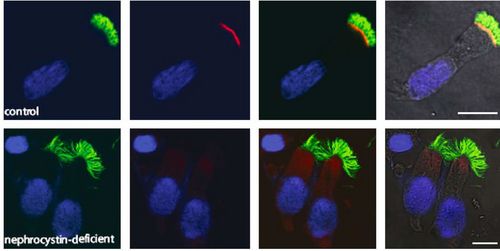Cystic Kidney Disease (Nephronophthisis)
Nephronophthisis is a rare autosomal recessive disorder affecting approximately 1:50,000 persons. It is the most common genetic cause of terminal renal failure in adolescence. To date, 19 genes (NPHP1 - NPHP19) have causative mutations for this disease. Depending on the gene that is mutated, kidney failure can occur between 0 and 19 years of age. The first signs of illness are polyuria (increased frequency of urination) and accordingly, polydipsia (constant thirst). The affected children have a characteristic need to drink at night. This is because the kidneys have decreased ability to concentrate urine due to loss of salts (electrolyte imbalance) and results in dehydration. Patients also increasingly suffer from anemia and metabolic acidosis. The diagnosis is usually made by an imaging technique in which the typical cortical medullary cysts are detected. Nephronophthisis may be associated with diseases of the eyes, liver, bone and cerebellum.
A similar clinical picture is observed in medullary cystic autosomal dominant kidney disease (MCKD), which leads to end-stage renal failure in adulthood. To date, two loci have been identified on chromosome 1q21 (ADMCKD1) and chromosome 16p12 (ADMCKD2). Both diseases are grouped under the term NPH / MCKD complex. Our research group has worked together with Prof. Hildebrandt (University of Michigan Medical School, USA) for more than 15 years to determine causative genes for nephronophthisis. Nephrocystins, the protein products of the Nephronophthisis genes, are located at the base of cilia and have contributed to better understanding of ciliary transport of certain proteins.
Unfortunately, except for renal replacement therapy (dialysis, renal transplantation), there is no current treatment for nephronophthisis. To better understand this rare and highly variable clinical illness, a registry of German-speaking countries (Germany / Austria / Switzerland) has been implemented. The aim of this registry is to carefully document both retro-and prospectively the disease progression and develop a consensus on the prevalence and prognosis in different age groups.
For physicians and patients interested in more detailed information on this complex disease, please click on the Nephronophthisis registry link: Register (German version)

NPHP1 (Nephrocystin (red)) is located at the base of respiratory epithelial cells. In patients, the protein is not detectable. This staining was performed in our laboratory.

